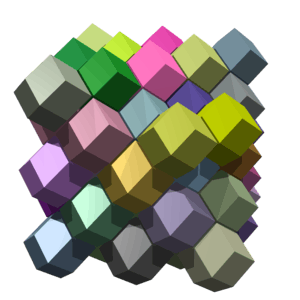Isohedral figure
In geometry, a polytope (a polyhedron or a polychoron for example) or tiling is isohedral or face-transitive when all its faces are the same. More specifically, all faces must be not merely congruent but must be transitive, i.e. must lie within the same symmetry orbit. In other words, for any faces A and B, there must be a symmetry of the entire solid by rotations and reflections that maps A onto B. For this reason, convex isohedral polyhedra are the shapes that will make fair dice.[1]
Isohedral polyhedra are called isohedra. They can be described by their face configuration. A form that is isohedral and has regular vertices is also edge-transitive (isotoxal) and is said to be a quasiregular dual: some theorists regard these figures as truly quasiregular because they share the same symmetries, but this is not generally accepted.
A polyhedron which is isohedral has a dual polyhedron that is vertex-transitive (isogonal). The Catalan solids, the bipyramids and the trapezohedra are all isohedral. They are the duals of the isogonal Archimedean solids, prisms and antiprisms, respectively. The Platonic solids, which are either self-dual or dual with another Platonic solid, are vertex, edge, and face-transitive (isogonal, isotoxal, and isohedral). A polyhedron which is isohedral and isogonal is said to be noble.
Examples
 The hexagonal bipyramid, V4.4.6 is a nonregular example of an isohedral polyhedron. |
 The isohedral Cairo pentagonal tiling, V3.3.4.3.4 |
 The rhombic dodecahedral honeycomb is an example of an isohedral (and isochoric) space-filling honeycomb. |
Related terms
A cell-transitive or isochoric figure is an n-polytope (n>3) or honeycomb that has its cells are congruent and transitive with each other.
A facet-transitive or isotopic figure is a n-dimensional polytopes or honeycomb, with its facets ((n-1)-faces) congruent and transitive. The dual of an isotope is an isogonal polytope. By definition, this isotopic property is common to the duals of the uniform polytopes.
- An isotopic 2-dimensional figure is isotoxal (edge-transitive).
- An isotopic 3-dimensional figure is isohedral (face-transitive).
- An isotopic 4-dimensional figure is isochoric (cell-transitive).
See also
- Edge-transitive
- Anisohedral tiling
Notes
References
- Peter R. Cromwell, Polyhedra, Cambridge University Press 1997, ISBN 0-521-55432-2, p. 367 Transitivity
External links
- Olshevsky, George, Isotope at Glossary for Hyperspace.
- Weisstein, Eric W., "Isohedral tiling", MathWorld.
- Weisstein, Eric W., "Isohedron", MathWorld.